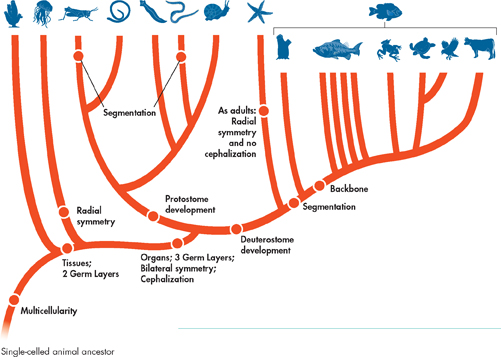
FIGURE 25–11 Cladogram of Animals This diagram illustrates evolutionary relationships among major groups of animals. (The major groups of phylum chordata are bracketed.) During the course of evolution, important traits evolved, sometimes more than once, as shown by the red circles. Apply Concepts Where do the traits acoelom, pseudocoelom, and coelom go on this cladogram?
dThe Cladogram of Animals
 How are animal phyla defined?
How are animal phyla defined?
The features of animal body plans you have just learned about provide information for building the cladogram, or phylogenetic tree, of animals. Recall that the evolutionary history presented in a cladogram represents a set of evolutionary hypotheses based on characteristics of living species, evidence from the fossil record, and comparative genomic studies. The cladogram in Figure 25–11 presents our current understanding of relationships among animal phyla.  Animal phyla are typically defined according to adult body plans and patterns of embryological development. For example, the phylum Arthropoda is defined by a body plan that includes bilateral symmetry, segmentation, cephalization, an external skeleton, and jointed legs.
Animal phyla are typically defined according to adult body plans and patterns of embryological development. For example, the phylum Arthropoda is defined by a body plan that includes bilateral symmetry, segmentation, cephalization, an external skeleton, and jointed legs.
Differences Between Phyla The cladogram of animals indicates the sequence in which important body plan features evolved. Every phylum has a unique combination of ancient traits inherited from its ancestors and new traits found only in that particular phylum. It may be tempting to think of a cladogram as a story about “improvements” from one phylum to the next over time. But that isn't the case. The complicated body systems of vertebrates aren't necessarily better than the “simpler” systems of invertebrates. Any system found in living animals functions well enough to enable those animals to survive and reproduce. For example, most chordate brains are more complex than the brains of flatworms. But flatworm brains obviously work well enough to enable flatworms, as a group, to survive.
MYSTERY CLUE

The mystery creatures are deuterostomes. Their larvae have bilateral symmetry, a dorsal hollow nerve cord, and pharyngeal pouches—but no backbone. Where on the cladogram do they belong?
Table of Contents
- Formulas and Equations
- Applying Formulas and Equations
- Mean, Median, and Mode
- Estimation
- Using Measurements in Calculations
- Effects of Measurement Errors
- Accuracy
- Precision
- Comparing Accuracy and Precision
- Significant Figures
- Calculating With Significant Figures
- Scientific Notation
- Calculating With Scientific Notation
- Dimensional Analysis
- Applying Dimensional Analysis




